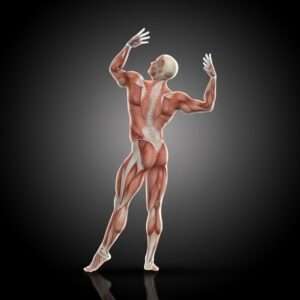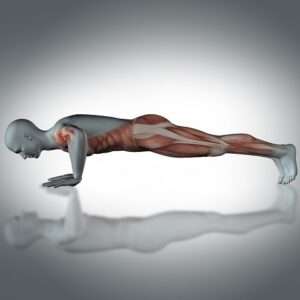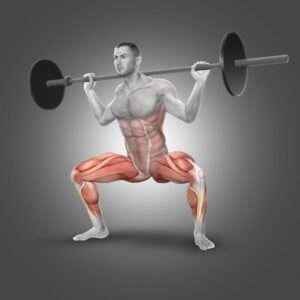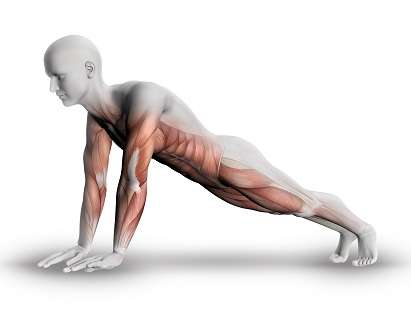
Types of movements caused by muscle activation in the human body are generated by muscles. When a muscle contracts, it exerts a force on the bones, resulting in joint action. The type of movement produced by muscle activation depends on the type of muscle fibers involved, the arrangement of the muscle fibers, and the type of joint involved.
There are three main types of muscle movements caused by muscle activation: isotonic, isometric, and isokinetic. Each type of movement involves a different muscle contraction and produces another kind of movement at the joint.
- Isotonic contractions involve constant muscle tension while the muscle length changes. This type of contraction moves the joint and can be further divided into concentric and eccentric contractions. Concentric contractions occur when the muscle shortens while generating tension, while eccentric contractions occur when the muscle lengthens while causing stress.
- Isometric contractions involve a constant muscle length while the muscle tension changes. In this type of contraction, the muscle generates force but does not produce any movement at the joint.
- Isokinetic contractions involve a constant muscle speed while the muscle tension changes. This type of contraction is usually performed using specialized equipment that maintains a steady rate throughout the movement. Isokinetic contractions can be either concentric or eccentric.
Understanding the different types of movements caused by muscle activation is essential for athletes, physical therapists, and anyone interested in optimizing their physical performance or improving their overall health and well-being.
Read more: You can also read about Muscles Groups-Physiohealthexpert
Table of Contents
Muscle Activation
Muscle activation refers to the process by which the nervous system sends signals to the muscle fibers, causing them to contract and produce force. This process involves the communication between the brain and the muscles through the neuromuscular system, which includes the motor neurons, muscle fibers, and neuromuscular junctions.
When a motor neuron fires an action potential, it travels down its axon and reaches the neuromuscular junction, releasing a neurotransmitter called acetylcholine. The acetylcholine then binds to receptors on the muscle fibers, triggering a series of chemical reactions that cause the muscle fibers to contract.
The degree of muscle activation can vary depending on the intensity and duration of the neural signal sent by the motor neuron. For example, a more robust signal will activate more muscle fibers and produce more significant force, while a weaker signal will activate fewer muscle fibers and produce less energy.
Muscle activation is essential for producing movement, maintaining posture, and performing various physical activities. It is also a necessary factor in strength training, where the goal is to increase muscle activation and force production to improve athletic performance and overall health.
Types Of Movements Caused By Muscle Activation
As mentioned, there are three main types of movements caused by muscle activation: isotonic, isometric, and isokinetic.
- Isotonic Contractions involve constant muscle tension while the muscle length changes. This type of contraction moves the joint and can be further divided into two types:
- Concentric Contractions: Concentric contractions occur when the muscle shortens while generating tension. For example, when you perform a bicep curl, your bicep muscles contract concentrically.
- Eccentric Contractions: Eccentric contractions occur when the muscle lengthens while generating tension. For example, when you lower weight during a bicep curl, your bicep muscles contract eccentrically.
- Isometric Contractions: Isometric contractions involve a constant muscle length while the muscle tension changes. In this type of contraction, the muscle generates force but does not produce any movement at the joint. For example, when you hold a plank position, your abdominal muscles contract isometrically.
- Isokinetic Contractions: Isokinetic contractions involve a constant muscle speed while the muscle tension changes. This type of contraction is usually performed using specialized equipment that maintains a steady rate throughout the movement. Isokinetic contractions can be either concentric or eccentric.
Understanding these different types of movements caused by muscle activation can help you tailor your exercise routine to your specific goals and needs. For example, suppose you want to improve your strength. In that case, you might focus on exercises that involve isotonic contractions, while if you improve your endurance, you might focus on activities that involve isometric contractions.
Isotonic Movements


Isotonic movements are types of movements caused by muscle activation that involves constant muscle tension while the muscle length changes. This means that the muscle contracts while moving the joint. The term “isotonic” comes from the Greek words “iso” (equal) and “tonos” (tension).
Isotonic movements can be further divided into two types: concentric and eccentric contractions.
Types of Isotonic Movements
| Concentric Muscle Contractions | Eccentric Muscle Contractions |
| “Concentric contractions,” are types of movements caused by muscle activation that occurs when the muscle shortens as it contracts. During a concentric contraction, the muscle fibers are activated and generate force as they pull on the tendons, causing the bone and joint to move. This type of contraction occurs when you lift a weight or perform a bicep curl, for example. Concentric contractions are essential for everyday activities, such as walking, running, and lifting objects. They also play a crucial role in sports performance and athletic training, as they can help build strength, power, and speed. Concentric muscle contractions occur when a muscle shortens as it contracts. During a concentric contraction, the muscle fibers generate force as they pull on the tendons, causing the bone and joint to move. This type of contraction is often associated with lifting a weight or performing a bicep curl. Concentric contractions are one of three main types of movements caused by muscle activation. Eccentric contractions occur when a muscle lengthens as it contracts, while isometric contractions occur when a muscle generates force but does not change length. Concentric contractions are essential for many activities, including everyday movements such as walking and running and athletic and sports performance. They can help to build strength, power, and speed and are often targeted in strength training exercises. | Eccentric muscle contractions are types of movements caused by muscle activation that occur when the muscle lengthens while contracting against a load. During an eccentric contraction, the muscle generates force while increasing rather than shortening, like during a concentric contraction. Eccentric contractions occur when you lower a weight, descend stairs, or control your movement during a jump. For example, during a bicep curl, the bicep muscle contracts eccentrically as it lengthens to lower the weight back to its starting position. Eccentric contractions are types of movements caused by muscle activation that are essential for many activities, including movements that require deceleration and control, such as landing from a jump or running downhill. Eccentric training can also be beneficial for building strength and muscle hypertrophy, as eccentric contractions have been shown to cause more muscle damage than concentric contractions. However, eccentric contractions also place more significant stress on the muscle fibers and can lead to more incredible muscle soreness and fatigue. Therefore, it is essential to gradually incorporate eccentric training under a qualified professional’s guidance to ensure safety and prevent injury. |
| Examples Of Concentric Muscle Contractions: There are many examples of concentric muscle contractions. Here are a few: Bicep curl: During a bicep curl, the muscle contracts concentrically as it shorten to lift the weight towards the shoulder. Squat: During a squat, the quadriceps muscles contract concentrically to extend the knee and raise the body from a lowered position. Push-up: During a push-up, the chest muscles and triceps contract concentrically to lift the body from the ground towards the arms. Walking: During walking, the leg muscles contract concentrically as they shorten to lift the body weight and move the leg forward. Jumping: During a jump, the leg muscles contract concentrically to generate force and propel the body off the ground. Shoulder press: During a shoulder press, the muscles contract concentrically to lift the weight overhead. These are just a few examples of movements that involve concentric muscle contractions. Concentric contractions are an essential component of many everyday activities and athletic performances. | Eccentric Muscle Contractions Examples: Here are some examples of eccentric muscle contractions: Lowering a weight: When you perform a bicep curl, for example, the bicep muscle contracts concentrically as you lift the weight, but it contracts eccentrically as you lower it back down. Descending stairs: When you descend stairs, your quadriceps muscles contract eccentrically to control your movement and prevent your body from falling forward. Landing from a jump: When you land from a jump, your leg muscles contract eccentrically to control the landing and absorb the impact. Running downhill: When you run downhill, your leg muscles contract eccentrically to control your speed and prevent your body from accelerating too quickly. Performing a Romanian deadlift: During a Romanian deadlift, the hamstrings contract eccentrically as you lower the weight toward the ground. Step-ups: During step-ups, your leg muscles contract eccentrically to lower your body back to the ground after stepping onto a platform. These are just a few exercises and movements involving eccentric muscle contractions. Incorporating eccentric training can be beneficial for building strength, power, and muscle hypertrophy and improving control and stability during dynamic activities. |
| Benefits Of Concentric Muscle Contractions: Concentric muscle contractions are types of movements caused by muscle activation these offers several benefits, including: Increased strength: Concentric contractions are an effective way to build strength, as they activate the muscle fibers and generate force to move the joint. Improved power: Concentric contractions are also crucial for generating power, essential for explosive movements like jumping or sprinting. Enhanced speed: Concentric contractions help to generate a rate, which is essential for athletic activities like running or cycling. Improved muscle tone: Concentric contractions can help to tone and shape muscles, as they activate the muscle fibers and cause them to contract. Improved functional movement: Concentric contractions are essential for everyday actions, such as lifting objects, walking, and climbing stairs. By improving concentric strength, you can quickly improve your ability to perform these activities. Injury prevention: Concentric contractions can help strengthen the muscles and joints, reducing the risk of injury during physical activity. Overall, incorporating exercises that focus on concentric contractions can help improve overall fitness and athletic performance while reducing the risk of injury. | Benefits Of Eccentric Muscle Contractions: Eccentric muscle contractions are types of movements caused by muscle activation these offer several benefits, including: Increased strength: Eccentric contractions can effectively build strength, as they can generate greater force than concentric contractions. Muscle hypertrophy: Eccentric contractions have been shown to cause more significant muscle damage than concentric contractions, which can stimulate muscle growth and hypertrophy. Improved power: Eccentric contractions can also be necessary for generating power, as they allow for more excellent force transfer to the load or movement. Improved control and stability: Eccentric contractions require greater power and strength, improving joint stability and reducing the risk of injury. Improved metabolic adaptations: Eccentric contractions have been shown to lead to more excellent metabolic adaptations, including increased muscle oxidative capacity and improved muscle fiber recruitment. Rehabilitation: Eccentric training can be particularly beneficial for rehabilitation following an injury, as it can help to restore strength and function to the affected muscles and joints. Overall, incorporating exercises that focus on eccentric contractions can improve overall fitness, athletic performance, and rehabilitation following an injury. However, it is essential to gradually integrate eccentric training under a qualified professional’s guidance to ensure safety and prevent damage. |
Isometric Contractions
Isometric contractions are types of movements caused by muscle activation when the muscle generates force without changing its length. This means the joint angle remains the same, and there is no movement or visible change in muscle length during the contraction.
For example, holding a plank position or pushing against an immovable object like a wall is an example of an isometric contraction. During a plank, the muscles in your core, back, and shoulders are contracted isometrically to maintain the position without any movement.
Isometric contractions are types of movements caused by muscle activation essential for many activities, such as maintaining posture, stabilizing the joints, and producing force without movement. They can also be used in rehabilitation to help strengthen muscles without placing excessive stress on the joints.
However, isometric contractions have some limitations. They do not typically lead to significant muscle hypertrophy, dynamic strength, or power improvements. Therefore, they are often combined with other contractions, such as concentric and eccentric, to produce a more comprehensive training program.
Examples Of Isometric Contractions

Here are some examples of isometric contractions:
- Plank: In a plank, you hold your body straight from head to heels, with your forearms on the ground and your toes on the floor. The muscles in your core, back, and shoulders are contracted isometrically to maintain the position without any movement.
- Wall sit: In a wall sit, you sit with your back against a wall and your knees bent at a 90-degree angle. The muscles in your legs are contracted isometrically to hold the position.
- Pushing against an immovable object: Pushing against an immovable object, such as a wall or a door frame, is an example of an isometric contraction. This can be used as a way to build upper body strength without the need for equipment.
- Placing a resistance band or towel between your hands and pulling it apart is an isometric contraction of the muscles in the chest and back.
- Holding a yoga pose: Many poses involve isometric contractions, such as a warrior pose or a chair pose.
- Holding a static position during a strength exercise: During strength exercises, such as a bicep curl or a shoulder press, you may weight a stationary position for some time to challenge the muscles.
These are just a few exercises and activities involving isometric contractions. Incorporating isometric training can be beneficial for building strength, stability, and endurance and can be part of a comprehensive training program that includes other types of contractions.
Benefits Of Isometric Contractions
Isometric contractions are types of movements caused by muscle activation that offer several benefits, including:
- Improved strength: Isometric contractions can be an effective way to build strength, particularly in the muscles involved in maintaining posture and stability, such as the core, back, and glutes.
- Improved stability and balance: Isometric contractions can help to improve joint strength and balance by strengthening the muscles that stabilize the joints.
- Rehabilitation: Isometric contractions can be particularly beneficial for rehabilitation following an injury, as they can help to build strength and stability without placing excessive stress on the joints.
- Improved endurance: Isometric contractions can help improve muscular endurance, as the muscles are required to maintain a contraction for an extended period.
- Convenient and accessible: Isometric contractions can be performed anywhere, as they do not require equipment or much space.
- Reduced risk of injury: Isometric contractions can be a safer way to train, as they do not involve movement and are less likely to cause damage than exercises that involve dynamic activities.
Overall, incorporating exercises that focus on isometric contractions can improve overall fitness, build strength and stability, and reduce the risk of injury. However, it is essential to gradually incorporate isometric training under a qualified professional’s guidance to ensure safety and prevent damage.
Isokinetic Contractions
Isokinetic contractions are types of movements caused by muscle activation when the muscle shortens or lengthens at a constant speed. Isokinetic contractions are typically performed using specialized equipment, such as an isokinetic dynamometer, which allows for precise control over the rate of the contraction.
During an isokinetic contraction, the resistance provided by the equipment is adjusted to match the force produced by the muscle throughout the entire range of motion. This means that the power is working against a constant load, and the speed of the contraction remains constant.
Isokinetic contractions are types of movements caused by muscle activation often used in rehabilitation and sports performance training to improve strength and flexibility. Because the speed of the contraction is controlled, the risk of injury is reduced, making isokinetic contractions a safe and effective way to train.
Isokinetic training can improve muscular strength, endurance, and power. It can also improve joint range of motion and reduce the risk of injury. However, isokinetic equipment can be expensive and not readily available in all fitness or rehabilitation settings.
Examples Of Isokinetic Contractions


Here are some examples of exercises that involve isokinetic contractions that are types of movements caused by muscle activation:
- Isokinetic leg press: This exercise consists in pressing against a leg press machine with a mechanism that adjusts resistance to match the force produced by the muscle throughout the range of motion.
- Isokinetic shoulder press: This exercise involves pressing against a shoulder press machine with a mechanism that adjusts resistance to match the force produced by the shoulder muscles throughout the range of motion.
- Isokinetic knee extension/flexion: This exercise involves extending or flexing the knee against a machine that provides resistance that matches the force produced by the muscles throughout the range of motion.
- Isokinetic bicep curl/triceps extension: These exercises involve contracting the bicep or tricep muscles against a machine that provides resistance that matches the force produced by the muscles throughout the range of motion.
- Isokinetic ankle dorsiflexion/plantarflexion: This exercise involves contracting the ankle muscles to move the foot up or down against a machine that provides resistance that matches the force produced by the muscles throughout the range of motion.
Isokinetic contractions can also be used in rehabilitation to help injured muscles regain strength and function. The equipment for isokinetic contractions can be expensive and unavailable in all gyms or clinics.
Benefits Of Isokinetic Contractions
Isokinetic contractions are types of movements caused by muscle activation that offer several benefits, including:
Controlled speed and resistance: Isokinetic contractions provide a steady speed and resistance throughout the entire range of motion, which can help to improve muscle strength, power, and endurance.
Reduced risk of injury: Because the speed and resistance are controlled, the risk of damage during isokinetic contractions is diminished. This makes isokinetic training a safe and effective way to train.
Targeted muscle activation: Isokinetic contractions can target specific muscle groups, which can help rehabilitate injured muscles or improve muscle imbalances.
Increased joint range of motion: Isokinetic contractions can help improve the combined range of motion, improving mobility and reducing the risk of injury.
Improved sports performance: Isokinetic training can improve muscle strength, power, and endurance, which can improve sports performance.
Efficient training: Isokinetic contractions can provide an efficient workout because they work the muscle throughout the entire range of motion and provide constant resistance, which can maximize results in a shorter amount of time.
Overall, incorporating isokinetic training into a workout routine can improve strength, power, and endurance, reduce the risk of injury, and improve sports performance. However, it is essential to use isokinetic equipment correctly and under the guidance of a qualified professional to ensure safety and prevent injury.
Summary
There are Three main types of movements caused by muscle activation, including:
Isometric Contractions are types of movements caused by muscle activation that causes no visible movement, as the muscle remains stationary. It occurs when the muscle generates tension, but the joint angle does not change.
Concentric Contractions are types of movements caused by muscle activation that results in the shortening of the muscle fibers and the movement of a body part towards the center of the body. This movement occurs when the muscle generates enough force to overcome the resistance.
Eccentric Contractions are types of movements caused by muscle activation that occurs when the muscle fibers lengthen under tension. It happens when the force generated by the muscle is less than the external load applied, causing the muscle to lengthen while still under tension.
Isotonic Contractions are types of movements caused by muscle activation that involves the contraction of the muscle to move a load or resistance through a range of motion. The muscle generates enough force to overcome the resistance, and the muscle length changes as the load is moved.
Isokinetic Contractions are types of movements caused by muscle activation that involves the contraction of the muscle at a constant speed throughout the range of motion. It occurs when the muscle contracts against a machine that provides resistance that matches the force applied by the muscle.
